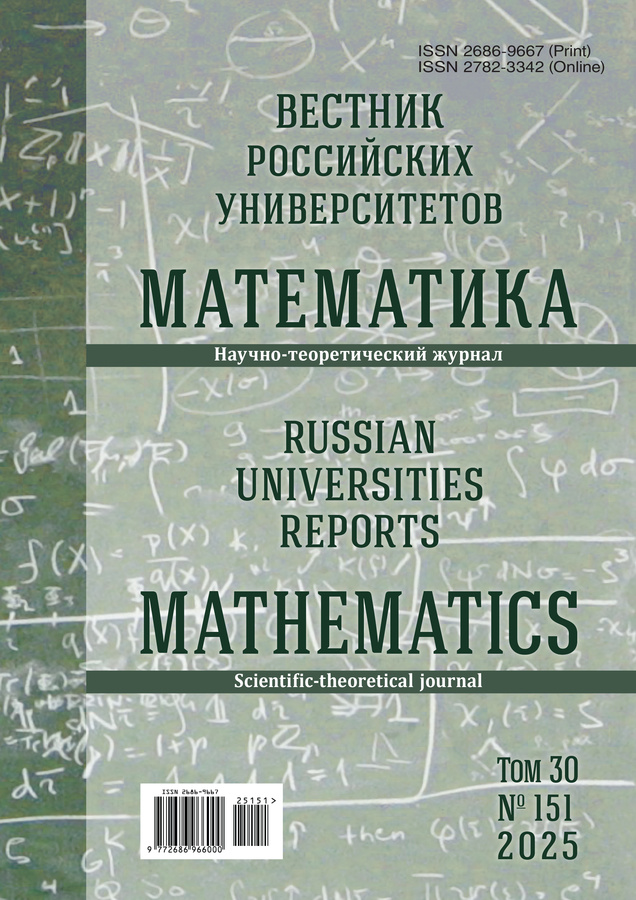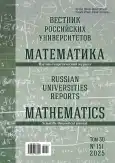Вестник российских университетов. Математика
Журнал «Вестник российских университетов. Математика» (Russian Universities Reports. Mathematics) является рецензируемым научно-теоретическим журналом, в котором публикуются статьи по математике и ее приложениям, содержащие новые математические результаты, и обзорные статьи, освещающие современное состояние актуальных проблем математики. Журнал предназначен для широкого круга специалистов в области математики, а также для научных работников и студентов, применяющих математические методы в естествознании, технике, экономике, гуманитарной сфере.
Основными задачами журнала являются: оперативная публикация новых оригинальных математических результатов, имеющих теоретическое и прикладное значение; информирование о направлениях исследований в различных разделах математики, о современных математических проблемах; содействие развитию приложений математических методов и результатов.
Издается с 14 июня 1996 года. По 27 мая 2019 г. выходил под названием «Вестник Тамбовского университета. Серия: естественные и технические науки» (ISSN 1810-0198).
Учредитель, издатель, редакция журнала – ФГБОУ ВО «Тамбовский государственный университет имени Г.Р. Державина» (392000, Тамбовская обл., г. Тамбов, ул. Интернациональная, д. 33, тел. +7(4752)72-34-40, e-mail: post@tsutmb.ru).
Издание зарегистрировано Федеральной службой по надзору в сфере связи, информационных технологий и массовых коммуникаций (Роскомнадзор), выписка из реестра зарегистрированных средств массовой информации (реестровая запись от 03 июля 2019 г. ПИ № ФС77-76133).
ISSN 2686-9667 (Print). ISSN 2782-3342 (Online).
Журнал является участником партнерств: «Комитет по этике научных публикаций» и профессионального сообщества «Ассоциация научных редакторов и издателей (АНРИ)», CrossRef (DOI журнала: 10.20310/2686-9667).
Периодичность: 4 номера в год (март, июнь, сентябрь, декабрь).
Тираж 1000 экземпляров.
Территория распространения журнала: Российская Федерация и зарубежные страны. Реализуется по подписке, на конференциях, выставках, через редакцию, вузы-партнеры.
Общее руководство по формированию и изданию научно-теоретического журнала осуществляет редакционная коллегия во главе с главным редактором. Главный редактор журнала – доктор физико-математических наук, профессор, директор НИИ математики, физики и информатики Тамбовского государственного университета им. Г.Р. Державина Евгений Семенович Жуковский.
Тематика журнала. Журнал публикует статьи, посвященные разнообразным направлениям и разделам математики (алгебра и логика, геометрия и топология, функциональный анализ, дифференциальные уравнения, оптимизация и управление, теория вероятностей и математическая статистика, вычислительные методы и др.), ее приложениям.
Печатаются работы трех основных видов:
– обзорные научные статьи, отражающие современное состояние исследований по некоторому математическому направлению;
– оригинальные научные статьи, описывающие результаты исследования конкретных математических проблем, содержащие полные доказательства полученных автором результатов;
– краткие сообщения, в которых приводятся результаты исследования конкретных математических проблем, содержащие точные формулировки без полных доказательств.
В журнале также публикуются материалы математических конференций, организуемых российскими университетами, рецензии, персоналии и информационные материалы о событиях математической жизни университетов.
Авторами журнала являются отечественные и зарубежные ученые. Редакция принимает рукописи на русском или английском языке.
Ознакомиться с требованиями к оформлению рукописей можно в разделах «Правила рецензирования», «Порядок направления, рецензирования и опубликования научных статей» и «Правила для авторов».
Публикации в журнале осуществляются на некоммерческой основе. Редакция не взимает плату с авторов за подготовку, размещение и печать материалов.
Индексирование
Журнал индексируется в базе данных Российского индекса научного цитирования (РИНЦ), входит в ядро РИНЦ, индексируется в базах данных Russian Science Citation Index (RSCI) на платформе Web of Science, Scopus.
Журнал включен в «Белый список», Перечень рецензируемых научных изданий, рекомендуемых Высшей аттестационной комиссией (ВАК) (К1).
Журнал включен в Zentralblatt MATH («Центральный журнал по математике») – реферативный математический журнал, основанный издательством «Шпрингер», и электронную базу данных “ZBMATH – The database Zentralblatt MATH”; в Норвежский реестр научных журналов, серий и издателей первого уровня (NSD); в Math-Net.Ru – общероссийский портал научной информации по математике, физике, информационным технологиям и смежным наукам; в Реферативный журнал и Базы данных ВИНИТИ РАН; в Международную базу данных научной литературы SciLIT; в крупнейшую Международную библиографическую базу данных американского издательства Bowker “Ulrich’s Periodicals Directory” (содержащую и описывающую мировой поток периодических изданий по всем тематическим направлениям жизнедеятельности).
Бесплатные полнотекстовые сетевые версии выпусков научно-теоретического журнала «Вестник российских университетов. Математика», а также аннотации и ключевые слова для всех научных статей и обзоров размещены в свободном доступе на русском и английском языках на платформах Научной электронной библиотеки eLIBRARY, электронной библиотеки «КиберЛенинка» и на Общероссийском портале Math-Net.Ru.
Авторские права
![]()
Журнал сохраняет за авторами авторские права без ограничений. При повторной публикации материалов автор обязуется дать ссылку на ранее опубликованные в журнале «Вестник российских университетов. Математика».

Журнал «Вестник российских университетов. Математика» предоставляет свободный доступ (Open Access journals) к полнотекстовым выпускам.
Политика в отношении плагиата
В редакции журнала «Вестник российских университетов. Математика» все статьи, поступающие на рассмотрение, проходят проверку в системе Антиплагиат.
Адрес редакции и издателя: 392000, Тамбовская обл., г. Тамбов, ул. Интернациональная, д. 33, Тамбовский государственный университет им. Г.Р. Державина.
Телефон редакции: 8(4752)72-34-34 доб. 0440.
Электронная почта редакции: zukovskys@mail.ru; ilina@tsutmb.ru
Редакционная коллегия, главный редактор журнала д. ф.-м. н. Жуковский Евгений Семенович.
Текущий выпуск
Том 30, № 151 (2025)
Научные статьи
Существование точки совпадения в критическом случае, когда константа накрывания и константа Липшица совпадают
Аннотация
Рассматриваются два отображения, действующие между метрическими пространствами, и такие, что одно из них является накрывающим, а второе удовлетворяет усиленному условию Липшица. При этом предполагается, что константа накрывания и константа Липшица у этих отображений совпадают. Доказывается результат о существовании точки совпадения однозначных отображений в случае, когда ряд из итераций функции, обеспечивающей выполнение усиленного условия Липшица, сходится. Доказывается аналогичный результат для многозначных отображений. Приводятся примеры функций, для которых ряд из их итераций сходится или расходится.
 209-217
209-217


О достаточных условиях асимптотической устойчивости положений равновесия разностных уравнений
Аннотация
В работе рассматриваются нелинейные разностные автономные системы первого порядка в вещественных конечномерных пространствах. Исследуется вопрос об устойчивости
положений равновесия для таких систем. Для разностного уравнения, порожденного гладким отображением $f,$ классические достаточные условия асимптотической устойчивости положения равновесия состоят в следующем. Если спектральный радиус первой производной отображения $f$ в точке равновесия строго меньше единицы, то рассматриваемое положение равновесия является асимптотически устойчивым. В настоящей работе приводятся новые достаточные условия асимптотической устойчивости положения равновесия, применимые и к широкому классу отображений, у которых указанный спектральный радиус может быть равен единице. Новые достаточные условия состоят в том, что существует выколотая окрестность заданного положения равновесия такая, что отображение, определяющее разностное уравнение, является локально сжимающим в каждой точке этой окрестности.
Приведен пример, в котором указанный спектральный радиус равен единице,
однако выполняются все предположения полученной теоремы об устойчивости. Показано, что известные достаточные условия устойчивости вытекают из результатов настоящей статьи. Важной особенностью предлагаемых результатов является то, что они применимы и к разностным уравнениям, порожденным непрерывными негладкими отображениями.
 218-225
218-225


Некоторые топологические свойства $f$-квазиметрических~пространств
Аннотация
Исследуются свойства $f$–квазиметрического пространства $(X,\rho).$ Расстояние $\rho$ в таком пространстве удовлетворяет аксиоме тождества и обобщенному неравенству треугольника: $\rho(x,z) \leq f(\rho(x,y),\rho(y,z))$ для любых $x,y,z\in X.$ Здесь функция $f$ положительна при положительных аргументах, непрерывна в точке $(0,0)$ и $f(0,0)=0.$ Симметричность расстояния не предполагается. Стандартно определяется топология на $X,$ порождаемая расстоянием $\rho.$ Исследуются свойства сходящихся последовательностей и секвенциально компактных множеств. Получены условия, при которых сходимость в себе (фундаментальность) необходима для сходимости последовательности. Рассмотрена связь скоростей сходимости фундаментальной последовательности и ее сходимости в себе. Введено понятие секвенциально предкомпактного множества. Получены условия, при которых замыкание секвенциально предкомпактного множества является секвенциально компактным.
 226-237
226-237


Оценки в классе аналитических функций, связанных с овалом Кассини, и некоторые их применения
Аннотация
Вводится и исследуется класс $\mathcal{P}_n(\varphi_\lambda)$ аналитических в открытом единичном круге $E$ функций $\varphi (z)=1 + c_n z^n + c_{n+1} z^{n+1} + \ldots,$ $n \geq 1,$ подчиненных функции $\varphi_\lambda(z)=1+{(1-\lambda)z}/{(1-\lambda z^2)},$ $0\le\lambda\ <1.$ С геометрической точки зрения это означает, что множество значений функции $\varphi(z)$ содержатся в области $\varphi_\lambda(E),$ ограниченной овалом Кассини.
Исследованы свойства мажоранты подчинения $\varphi_\lambda(z).$ На основе этого, опираясь на метод подчиненности аналитических функций, в классе $\mathcal{P}_n(\varphi_\lambda)$ установлены точные оценки $\rm{Re}\,\varphi(z),$ $\left|\varphi (z)\right|$ и $\left|z\varphi^\prime(z)/\varphi(z)\right|,$ в частном случае приводящие к одному из классических результатов.
Рассмотрено применение данных оценок для исследования экстремальных свойств некоторых классов аналитических в $E$ функций $f(z)$ вида $f(z)=z+a_{n+1}z^{n+1}+a_{n+2}z^{n+2}+\ldots,$ $n\geq1.$ В частности, получены теоремы роста, покрытия и радиусы выпуклости одного класса звездообразных функций, который построен с~использованием функции $\varphi_\lambda(z)$ и обобщает известный подкласс звездообразных функций Р.~Сингха. Также даны приложения полученных результатов к исследованию некоторых классов почти звездообразных и дважды почти звездообразных функций, связанных с функцией $\varphi_\lambda(z).$ В частности, в этих классах установлены теоремы роста и найдены радиусы звездообразности. Все полученные результаты являются точными, представляют собой как новые оригинальные результаты, так и некоторые обобщения известных результатов.
 238-254
238-254


Задачи оптимального периодического сбора ресурса для моделей популяций, заданных разностными уравнениями
Аннотация
Рассматриваются модели однородных или структурированных (по виду, возрасту или иному признаку) популяций, динамика которых при отсутствии эксплуатации задана системой разностных уравнений
$x(k+1) = F\big(k, x(k)\big),$\!
где $x(k) = \big(x_1(k), \ldots, x_n(k)\big),$ $x_i(k),$ $i=1,\ldots,n$~--- численность $i$-го вида или возрастного класса популяции в момент времени $k=0,1,2,\ldots;$ $F(k,x)=\bigl(F_1(k,x), \ldots, F_n(k,x)\bigr),$ $F_i(k,x)$~--- вещественные функции, которые определены и непрерывны на множестве $\mathbb{R}^n_+ \doteq\big\{x\in\mathbb{R}^n : x_1\geqslant0, \ldots, x_n\geqslant0\big\}.$
Предполагается, что в моменты времени $k=1, 2, \ldots$ популяция подвержена промысловому воздействию $u(k)=(u_1(k),\ldots,u_n(k))\in[0, 1]^n.$ Тогда исследуется модель эксплуатируемой популяции, заданной системой разностных уравнений
$X(k+1) = F\bigl(k,(1-u(k))X(k)\bigr), \quad k=1, 2, \ldots,$
где $X(k)=\big(X_1(k), \ldots, X_n(k)\big),$
$(1-u(k))X(k)=\big((1-u_1(k))X_1(k),\ldots,(1-u_n(k))X_n(k)\big),$ $X_i(k)$ и ${(1-u_i(k))X_i(k)}$~---
количество ресурса $i$-го вида до и после сбора в момент $k$ соответственно, $i=1,\ldots,n.$
Исследуется задача оптимального сбора возобновляемого ресурса на неограниченном промежутке времени при периодическом режиме эксплуатации, при
котором достигаются наибольшие значения характеристик сбора. Первая из таких характеристик~--- средняя временная выгода, заданная пределом при
$k\to\infty$ среднего арифметического стоимости ресурса за $k$ сборов. Другая~--- эффективность сбора, равная пределу при $k\to\infty$
отношения стоимости ресурса, полученной за $k$ сборов, к сумме приложенных для этого управлений (усилий сбора). Результаты работы проиллюстрированы
на примерах однородной эксплуатируемой популяции, заданной дискретным логистическим уравнением, и структурированной популяции, состоящей из двух видов.
 255-266
255-266


О зависимости неподвижной точки от параметра\\ в $(q_1, q_2)$-квазиметрических пространствах
Аннотация
В статье исследуется вопрос о непрерывной зависимости неподвижных точек сжимающих отображений, действующих в $(q_{1}, q_{2})$-квазиметрических пространствах, от параметра. Рассматривается уравнение вида $x = F(x, p).$ В нем $x\in X$ --- это неизвестная, принадлежащая полному $(q_{1}, q_{2})$-квазиметрическому пространству $X,$ $p$ --- это параметр, лежащий в заданном топологическом пространстве $P,$ а $F:X\times P\to X$ --- это заданное отображение. Предполагается, что это отображение является сжимающим по переменной $x.$ С использованием известных условий существования и единственности неподвижной точки сжимающих отображений полных $(q_{1}, q_{2})$-квазиметрических пространств, получены достаточные условия, при которых отображение, которое каждому $p\in P$ ставит в соответствие решение $x(p)$ рассматриваемого уравнения, является непрерывным. Получено следствие, гарантирующее непрерывность отображения $x(p)$ в случае, когда $X$ является полным метрическим пространством. Кроме того, рассмотрен случай, когда топологическое пространство $P$ является $(q_{1}, q_{2})$-квазиметрическим пространством. Получены достаточные условия липшицевости отображения $x(p),$ получена оценка константы Липшица этого отображения. Выведено следствие этого результата для случая, когда $X$ является полным метрическим пространством, а пространство параметров $P$ является метрическим.
 267-274
267-274


Метод возмущений и регуляризация принципа Лагранжа в нелинейной задаче оптимального управления с поточечным фазовым ограничением-равенством
Аннотация
Рассматривается регуляризация принципа Лагранжа (ПЛ) и теоремы Куна-Таккера (TKT) в недифференциальной форме в нелинейной (невыпуклой) задаче оптимального управления системой обыкновенных дифференциальных уравнений с поточечным фазовым ограничением-равенством. Существование решения задачи априори не предполагается. Ограничение-равенство содержит аддитивно входящий в него параметр, что обеспечивает возможность применения для исследования задачи "нелинейного варианта" метода возмущений. Основное предназначение регуляризованных ПЛ и TKT - устойчивое генерирование обобщенных минимизирующих последовательностей (ОМП) в рассматриваемой задаче. Их можно трактовать как ОМП-образующие (регуляризирующие) операторы, ставящие в соответствие каждому набору исходных данных задачи субминималь (минималь) ее отвечающего этому набору регулярного модифицированного функционала Лагранжа (МФЛ), двойственная переменная в котором генерируется в соответствии с процедурой стабилизации по Тихонову двойственной задачи. Конструкция МФЛ полностью определяется видом "нелинейных" субдифференциалов (проксимальный субградиент, субдифференциал Фреше) полунепрерывной снизу функции значений как функции параметра задачи. Регуляризованные ПЛ и TKT "преодолевают" свойства некорректности классических аналогов, составляя тем самым теоретическую основу для создания устойчивых методов решения нелинейных задач оптимального управления. В частном случае, когда задача регулярна в смысле существования в ней обобщенного вектора Куна-Таккера, а ее исходные данные аффинным образом зависят от управления, предельный переход в соотношениях регуляризованной TKT ведет к условиям оптимальности в форме соответствующих недифференциальной TKT и принципа максимума Понтрягина.
 275-304
275-304










